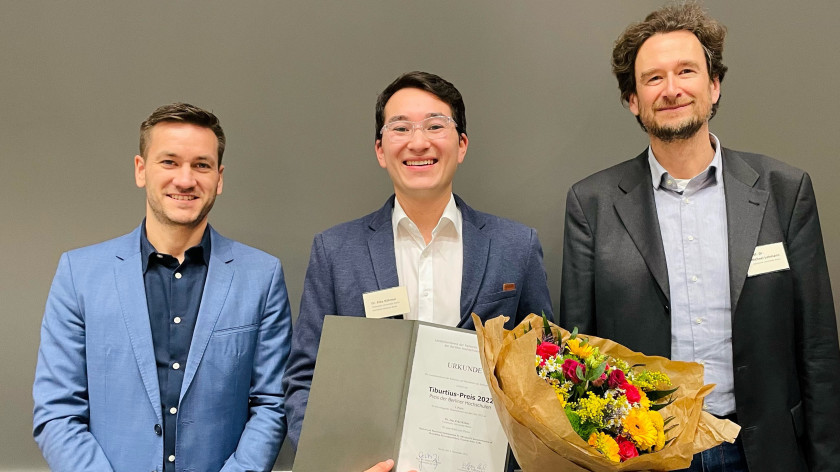Tiburtius Prize for Eike Köhnen

Eike Köhnen (center) was awarded with the Tiburtius Prize for his outstanding dissertation on tandem solar cells with perovskites. In the team of Prof. Steve Albrecht (left, TU Berlin and HZB) he was involved in several world records. Prof. Michael Lehmann (TU Berlin) gave the laudatory speech.
On Tuesday, 6 December 2022, Dr. Eike Köhnen received the Tiburtius Prize (First Place) for outstanding dissertations. Eike Köhnen has contributed to significantly increasing the efficiency of tandem solar cells made of perovskite and silicon, to the point of setting world records.
Eike Köhnen worked on so-called tandem solar cells, a new type of photovoltaic technology that promises significantly higher efficiencies. In Prof. Steve Albrecht's team (TU Berlin and HZB), he combined conventional silicon solar cells with a perovskite cell and analysed with state-of-the-art methods how losses can occur. These insights helped to increase the efficiency of such tandem solar cells to over 29 %. This value was an absolute world record for more than eight months.
Köhnen also obtained two patents as a PhD student. His thesis was assessed with the top mark summa cum laude. In Albrecht's team, Eike Köhnen was also active in science communication and maintained a lively Twitter account.
"The Tiburtius Prize is an outstanding recognition of this excellent dissertation and Eike's pioneering work in the development of solar cells," says Prof. Steve Albrecht, who supervised the PhD-thesis. Co-supervisor Prof. Bernd Rech, who heads the Helmholtz-Zentrum Berlin as scientific director, adds: "Eike Köhnen has played a major role in our internationally visible successes with tandem solar cells made of perovskite and silicon. I congratulate him on this fine award."
The award is named after Professor Joachim Tiburtius, who was Senator for National Education in Berlin from 1951 to 1963. The State Conference of Rectors and Presidents of Berlin Universities (LKRP) awards three prizes annually, as well as an additional three recognition prizes, to doctoral students at Berlin universities for outstanding dissertations
Title of the dissertation by Eike Köhnen: Optical and Electrical Optimization by Advanced Characterization of Monolithic Perovskite/Silicon Tandem Solar Cells.
arö
https://www.helmholtz-berlin.de/pubbin/news_seite?nid=24327;sprache=en
- Copy link
-
Battery research: visualisation of aging processes operando
Lithium button cells with electrodes made of nickel-manganese-cobalt oxides (NMC) are very powerful. Unfortunately, their capacity decreases over time. Now, for the first time, a team has used a non-destructive method to observe how the elemental composition of the individual layers in a button cell changes during charging cycles. The study, now published in the journal Small, involved teams from the Physikalisch-Technische Bundesanstalt (PTB), the University of Münster, researchers from the SyncLab research group at HZB and the BLiX laboratory at the Technical University of Berlin. Measurements were carried out in the BLiX laboratory and at the BESSY II synchrotron radiation source.
-
New instrument at BESSY II: The OÆSE endstation in EMIL
A new instrument is now available at BESSY II for investigating catalyst materials, battery electrodes and other energy devices under operating conditions: the Operando Absorption and Emission Spectroscopy on EMIL (OÆSE) endstation in the Energy Materials In-situ Laboratory Berlin (EMIL). A team led by Raul Garcia-Diez and Marcus Bär showcases the instrument’s capabilities via a proof-of-concept study on electrodeposited copper.
-
Green hydrogen: A cage structured material transforms into a performant catalyst
Clathrates are characterised by a complex cage structure that provides space for guest ions too. Now, for the first time, a team has investigated the suitability of clathrates as catalysts for electrolytic hydrogen production with impressive results: the clathrate sample was even more efficient and robust than currently used nickel-based catalysts. They also found a reason for this enhanced performance. Measurements at BESSY II showed that the clathrates undergo structural changes during the catalytic reaction: the three-dimensional cage structure decays into ultra-thin nanosheets that allow maximum contact with active catalytic centres. The study has been published in the journal ‘Angewandte Chemie’.
